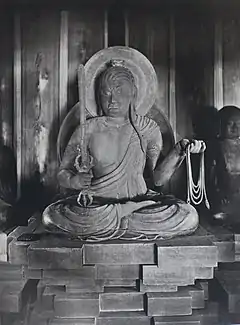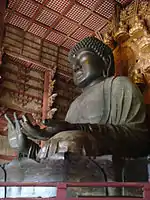Acala
Acala or Achala (Sanskrit: अचल, "The Immovable"), also known as Acalanātha (अचलनाथ, "Immovable Lord") or Āryācalanātha (आर्याचलनाथ, "Noble Immovable Lord"), is a wrathful deity and dharmapala (protector of the Dharma) prominent in Vajrayana Buddhism and East Asian Buddhism.[1]
| Acala | |
|---|---|
 Statue of Fudō Myōō (Acala), from early 13th century (Kamakura period) Japan | |
| Sanskrit | अचल (Acala) अचलनाथ (Acalanātha) |
| Chinese | (Traditional) 不動明王 (Simplified) 不动明王 (Pinyin: Bùdòng Míngwáng) 不動金剛明王 / 不动金刚明王 (Bùdòng Jīngāng Míngwáng) |
| Japanese | 不動明王 (Fudō Myōō) 大日大聖不動明王 (Dainichi Daishō Fudō Myōō) |
| Korean | 부동명왕 (Budong Myeongwang) |
| Mongolian | Хөдөлшгүй (Khödölshgüi) |
| Tibetan | མི་གཡོ་བ་ (Miyowa) |
| Vietnamese | Bất Động Minh Vương |
| Information | |
| Venerated by | Vajrayana Buddhism, Mahayana Buddhism, Shugendō |
| Attributes | vajra, lasso (pāśa), sword |
Originally a minor deity described as a messenger or acolyte of the buddha Vairocana, Acala later rose to prominence as an object of veneration in his own right as a remover of obstacles and destroyer of evil, eventually becoming seen as the wrathful manifestation of either Vairocana, the buddha Akṣobhya, or the bodhisattva Mañjuśrī. In later texts, he is also called Caṇḍaroṣaṇa (चण्डरोषण, "Violent Wrathful One") or Caṇḍamahāroṣaṇa (चण्डमहारोषण, "Violent One of Great Wrath"), the names by which he is more commonly known in countries like Nepal and Tibet.[2][3][4]
In East Asian esoteric Buddhism, Acala is classed among the wisdom kings (vidyārāja) and is preeminent among the Five Wisdom Kings of the Womb Realm. Accordingly, he occupies an important hierarchical position in the Mandala of the Two Realms. In China, he is known as Budong Mingwang (不動明王, "Immovable Wisdom King", the Chinese translation of Sanskrit Acala Vidyārāja[5]), while in Japan, he is called Fudō Myōō, the on'yomi reading of his Chinese name.[6] Acala (as Fudō) is one of the especially important and well-known divinities in Japanese Buddhism, being especially venerated in the Shingon, Tendai, Zen, and Nichiren sects, as well as in Shugendō.
Acala has been popular throughout the Middle Ages and into modern times in Nepal, Tibet and Japan, where sculptural and pictorial representations of him are most often found.[1][3]
Origins and development
Acala first appears in the Amoghapāśakalparāja Sūtra (不空羂索神変真言經 Bùkōng juànsuǒ shénbiàn zhēnyán jīng, translated by Bodhiruci circa 707-709 CE[7]), where he is described as a servant or messenger of the buddha Vairocana:[8]
The first from the west in the northern quadrant is the acolyte Acala (不動使者). In his left hand he grasps a noose and in his right hand he holds a sword. He is seated in the half-lotus position.[8][9]
More well-known, however, is the following passage from the Mahāvairocana Tantra which refers to Acala as one of the deities of the Womb Mandala:
Below the lord of mantras, in the southwestern direction, is Acala, servant of the Tathāgata (不動如来使). He holds the sword of wisdom and the noose (pāśa). His hair hangs on his left shoulder. One eye lightly squinting, he gazes intently. Blazing flames radiate from his awe-inspiring body. He dwells on a large rock. On his forehead are wrinkles like waves on the water. He is a young boy with a plump body.[8][10]
The deity was apparently popular in India during the 8th-9th centuries as evident by the fact that six of the Sanskrit texts translated by the esoteric master Amoghavajra into Chinese are devoted entirely to him.[3]
While some scholars have put forward the theory that Acala originated from the Hindu god Shiva, particularly his attributes of destruction and reincarnation,[11][12] Bernard Faure suggested the wrathful esoteric deity Trailokyavijaya (whose name is an epithet of Shiva), the Vedic fire god Agni, and the guardian deity Vajrapāṇi to be other, more likely prototypes for Acala. He notes: "one could theoretically locate Acala's origins in a generic Śiva, but only in the sense that all Tantric deities can in one way or another be traced back to Śiva."[8] Faure compares Acala to Vajrapāṇi in that both were originally minor deities who eventually came to occupy important places in the Buddhist pantheon.[13]
Acala is said to be a powerful deity who protects the faithful by burning away all impediments (antarāya) and defilements (kleśa), thus aiding them towards enlightenment.[14] In a commentary on the Mahāvairocana Tantra by Yi Xing, he is said to have manifested in the world following Vairocana's vow to save all beings, and that his primary function is to remove obstacles to enlightenment.[8] Indeed, the tantra instructs the ritual practitioner to recite Acala's mantras or to visualize himself as Acala in order to remove obstacles.[15]
From a humble acolyte, Acala evolved into a powerful demon-subduing deity. In later texts such as the Caṇḍamahāroṣaṇa Tantra, Acala - under the name Caṇḍaroṣaṇa ("Violent Wrathful One") or Caṇḍamahāroṣaṇa ("Violent One of Great Wrath") - is portrayed as the "frightener of gods, titans, and men, the destroyer of the strength of demons" who slays ghosts and evil spirits with his fierce anger.[3][16] In the Sādhanamālā, the "wicked" Hindu gods Vishnu, Shiva, Brahma and Kandarpa who subject humanity to endless rebirth are said to be terrified of Acala because he carries a rope to bind them.[3]

In Tibetan Buddhism, Acala or Miyowa (མི་གཡོ་བ་, Wylie: mi g.yo ba) is considered as belonging to the vajrakula ("vajra family", Tibetan: དོ་རྗེའི་རིགས་, dorjé rik), a category of deities presided over by the buddha Akṣobhya and may even be regarded, along with the other deities of the kula, as an aspect or emanation of the latter.[3][17][18][19] Indeed, he is sometimes depicted in South Asian art wearing a crown bearing an effigy of Akṣobhya.[3][18][19] In Nepal, Acala may also be identified as a manifestation of the bodhisattva Mañjuśrī.[20][21][22] He has a consort named Viśvavajrī in both the Nepalese and Tibetan traditions, with whom he is at times depicted in yab-yum union.[4][21]
By contrast, in the Japanese Shingon school, Acala is considered to be a fierce manifestation of Vairocana. According to the sanrinjin (三輪身, "three cakra bodies") theory prevalent in Japanese esoteric Buddhism, the five vidyārājas or wisdom kings (明王, myōō), of which Acala is one, are incarnations of the Five Tathāgatas known as "embodiments of the wheel of injunction" (教令輪身, kyōryō rinshin).[23][24] In this theory, the five buddhas manifest themselves in both benevolent and wrathful forms, appearing as gentle bodhisattvas to teach the Dharma to sentient beings and as terrifying wisdom kings to subdue and convert hardened nonbelievers.[25] Under this conceptualization, the wisdom kings are ranked superior to the dharmapala (護法善神, gohō zenshin),[26] a different class of guardian deities. However, this interpretation, while common, is not necessarily universal: in Nichiren-shū, for instance, Acala and Rāgarāja (Aizen Myōō), the two vidyārājas who commonly feature in the mandalas inscribed by Nichiren, are seen as protective deities (外護神, gegoshin) who are the respective embodiments of the concepts of shōji soku nehan (生死即涅槃, "the sufferings of life and death (saṃsāra) are nirvana") and bonnō soku bodai (煩悩即菩提, "earthly desires (kleśa) lead to enlightenment (bodhi)").[27][28][29]
Texts
As noted above, Acala appears in the Amoghapāśakalparāja Sūtra and the Mahāvairocana Tantra (also known as the Mahāvairocana Abhisaṃbodhi Tantra or the Vairocana Sūtra). As Caṇḍaroṣaṇa or Caṇḍamahāroṣaṇa, he is the primary deity of the Caṇḍamahāroṣaṇa Tantra and is described in the Sādhanamālā.
The Japanese esoteric Buddhist tradition and Shugendō also make use of following apocryphal sutras on Acala:
- Sūtra of the Great Wrathful King Āryācala's Secret Dhāraṇī (聖無動尊大威怒王秘密陀羅尼経, Shō-Mudō-son daiifunnuō himitsu darani kyō)
- A sūtra in the form of a discourse given by the bodhisattva Vajrasattva (identified here with Samantabhadra) to Mañjuśrī concerning Acala's nature. Acala, identified in this text with the all-pervading dharmakāya, is here said to "have no fixed abode, but dwells within the minds and hearts of sentient beings" (無其所居、但住衆生心想之中).[30][31]
- Āryācala Sūtra (仏説聖不動経, Bussetsu Shō-Fudō kyō)
Bījā and mantra

The bīja or seed syllables representing Acala are hāṃ (हां / हाँ) and hāmmāṃ (हाम्मां / हाम्माँ), the latter being a combination of the two final bīja in his mantra: hāṃ māṃ (हां मां).[36][37] Hāṃ is sometimes confounded with the similar-looking hūṃ (हूं), prompting some commentators to mistakenly identify Acala with other deities.[38] In Japanese Buddhism, the syllables are written using the Siddham script and is conventionally read as kān (カーン) and kānmān (カーンマーン).[36][39][40]
Three mantras of Acala are considered to be the standard in the Japanese tradition. The most widely known one, derived from the Mahāvairocana Tantra and popularly known as the "Mantra of Compassionate Help" (慈救呪, jikushu or jikuju), goes as follows:[41][42]
Sanskrit: Namaḥ samanta-vajrānāṃ caṇḍa-mahāroṣaṇa sphoṭaya hūṃ traṭ hāṃ māṃ[37]
English translation: Homage to the all-encompassing Vajras! O violent one of great wrath, destroy! hūṃ traṭ hāṃ māṃ.
Shingon pronunciation: Nōmaku sanmanda bazarada(n) senda(n) makaroshada sowataya un tarata kan man[43][44]Tendai pronunciation: Namaku samanda basaranan senda makaroshana sowataya un tarata kan man[45][46]

The "Short Mantra" (小呪, shōshu) of Acala - also found in the Mahāvairocana Tantra[47] - is as follows:
Sanskrit: Namaḥ samanta-vajrānāṃ hāṃ
Shingon: Nōmaku sanmanda bazaradan kan[48][49]
The longest of the three is the "Great Mantra" of Acala, also known as the "Fire Realm Mantra" (火界呪, kakaishu / kakaiju):[50]
Sanskrit: Namaḥ sarva-tathāgatebhyaḥ sarva-mukhebhyaḥ sarvathā traṭ caṇḍa-mahāroṣaṇa khaṃ khā he khā he (or khāhi khāhi[51]) sarva-vighnaṃ hūṃ traṭ hāṃ māṃ[52]
Shingon: Nōmaku saraba tatagyateibyaku saraba bokkeibyaku sarabata tarata senda makaroshada ken gyaki gyaki saraba bikin(n)an un tarata kan man[44][48][49]
Another mantra associated with the deity is Oṃ caṇḍa-mahāroṣaṇa hūṃ phaṭ, found in the Siddhaikavīra Tantra. The text describes it as the "king of mantras" that dispels all evil and grants "whatever the follower of Mantrayāna desires".[53]
Iconography
.jpg.webp)
The Caṇḍamahāroṣaṇa Tantra's description of Acala is a good summary of the deity's depiction in South Asian Buddhist art.
"His right hand is terrifying with a sword in it,
His left is holding a noose;
He is making a threatening gesture with his index finger,
And bites his lower lip with his fangs.
"Kicking with his right foot,
He is smashing the four Māras.
His left knee is on the ground.
Squint eyed, he inspires fear.
"He points a threatening gesture at Vasudhā [i.e. the earth],
Kneeling on the cap of his left knee.
He has Akṣobhya for his crest jewel;
He is of blue color and wears a jewel diadem.
"A princely youth, Wearing Five Braids of Hair,
Adorned with all the ornaments,
He appears to be sixteen years old,
And his eyes are red—he, the powerful one."[16]

In Nepalese and Tibetan art, Acala is usually shown either kneeling on his left knee or standing astride, bearing a noose or lasso (pāśa) and an upraised sword. Some depictions may portray him trampling on the elephant-headed Vighnarāja (the Hindu god Ganesha), the "Lord of Hindrances". He may also be shown wearing a tiger skin, with snakes coiled around his arms and body.[3][54]
By contrast, portrayals of Acala (Fudō) in Japan tend to conform to the description given in the Amoghapāśakalparāja Sūtra and the Mahāvairocana Tantra: holding a lasso and a sword while sitting or standing on a rock (盤石座, banjakuza) or a pile of hewn stones (瑟瑟座, shitsushitsuza), with his braided hair hanging from the left of his head.[55][56][57] He may also be depicted with a lotus flower - a symbol of enlightenment - on his head (頂蓮, chōren).[58] Unlike the South Asian Acala (whose standing or kneeling posture conveys movement and dynamism), the Japanese Fudō sits or stands erect, suggesting motionlessness and rigidity.[8] The sword he wields may or may not be flaming and is sometimes described generically as a "jeweled sword" (宝剣, hōken) or "vajra sword" (金剛剣, kongō-ken), which is descriptive of the fact that the sword's pommel is in the shape of the talon-like vajra (金剛杵, kongō-sho). It may also be referred to as a "three-pronged vajra sword" (三鈷剣, sanko-ken).[59] In some cases, he is seen holding the "Kurikara sword" (倶利伽羅剣, Kurikara-ken),[60] a sword with the dragon (nāga) king Kurikara (倶利伽羅; Sanskrit: Kulikāla-rāja or Kṛkāla-rāja) coiled around it.[61] The flaming nimbus or halo behind Acala is known in Japanese as the "Garuda flame" (迦楼羅炎, karura-en), after the mythical fire-breathing bird from Indian mythology.[14]

Whereas earlier Japanese images showed Acala with glaring eyes and two fangs pointing upwards, a new variation developed by the late Heian period which depicted him with one eye wide open and/or looking upwards, with the other narrowed and/or looking downwards - an iconographic trait known as the tenchigan (天地眼), "heaven-and-earth eyes". Similarly, one of his fangs is now shown as pointing up, with the other pointing down.[57][62][63][64]
Acala is commonly shown as having either black or dark blue skin, though he may be at times portrayed in other colors. In Tibet, for instance, a variant of the kneeling Acala depiction shows him as being white in hue "like sunrise on a snow mountain reflecting many rays of light".[65] In Japan, some images may depict Acala sporting a red (赤不動, Aka-Fudō) or yellow (黄不動, Ki-Fudō) complexion. The most famous example of the Aka-Fudō portrayal is a painting attributed to the Tendai monk Enchin kept at Myōō-in on Mount Kōya (Wakayama Prefecture). The Ki-Fudō image, enshrined in Mii-dera (Onjō-ji) at the foot of Mount Hiei in Shiga Prefecture, is meanwhile said to have been based on a vision that Enchin saw while practicing austerities in 838. The original Ki-Fudō is a 'hidden buddha' or hibutsu (秘仏, Buddhist images hidden from public view) traditionally only shown to esoteric masters (ācārya; 阿闍梨, ajari) during initiation rites, though copies of it have been made. One such copy, made in the 12th century, is kept at Manshu-in in Kyoto.[66][67][68][69][70]
The deity is usually depicted with one head and two arms, though a few portrayals show him with multiple heads, arms or legs.[71] In Japan, a depiction of Acala with four arms is employed in subjugation rituals and earth-placating rituals (安鎮法, anchin-hō).[72] An iconographic depiction known as the "Two-Headed Rāgarāja" (両頭愛染, Ryōzu Aizen or Ryōtō Aizen) shows Acala combined with the wisdom king Rāgarāja (Aizen).[73][74][75]
Acolytes

Acala is sometimes described as having a retinue of acolytes, the number of which vary between sources, usually two or eight but sometimes thirty-six or even forty-eight. These represent the elemental, untamed forces of nature that the ritual practitioner seeks to harness.[1][76]
The two kumāra or boy servants (童子, dōji) most commonly depicted in Japanese iconographic portrayals are Kiṃkara (矜羯羅童子, Kongara-dōji) and Ceṭaka (吒迦童子, Seitaka-dōji), who also appear as the last two of the list of Acala's eight great dōji.[1][14][76] Kiṃkara is depicted as white in color, with his hands joined in respect, while Ceṭaka is red-skinned and holds a vajra in his left hand and a vajra staff in his right hand. The two are said to symbolize both Dharma-essence and ignorance, respectively, and is held to be in charge of good and evil.[76]
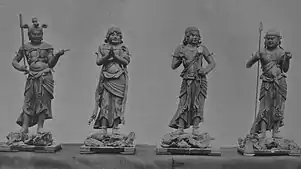
Kiṃkara and Ceṭaka are also sometimes interpreted as transformations or emanations of Acala himself. In a sense, they reflect Acala's original characterization as an attendant of Vairocana; indeed, their servile nature is reflected in their names (Ceṭaka for instance means "slave") and their topknots, the mark of banished people and slaves. In other texts, they are also described as manifestations of Avalokiteśvara (Kannon) and Vajrapāṇi or as transformations of the dragon Kurikara, who is himself sometimes seen as one of Acala's various incarnations.[76]
Two other notable dōji are Matijvala (恵光童子, Ekō-dōji) and Matisādhu (恵喜童子, Eki-dōji), the first two of Acala's eight great acolytes. Matijvala is depicted as white in color and holds a three-pronged vajra in his right hand and a lotus topped with a moon disk on his left, while Matisādhu is red and holds a trident in his right hand and a wish-fulfilling jewel (cintāmaṇi) on his left. The eight acolytes as a whole symbolize the eight directions, with Matijvala and Matisādhu representing east and south, respectively.[76]
Worship
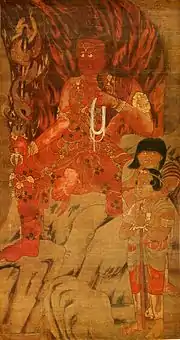
Japan
In Japan, Acala became a focus of worship in his own right, and became installed as the main deity at temples and outdoor shrines. A famous example is the Narita Fudō-dō, a Shingon subsect temple at Narita-san.[1]
At temples dedicated to Acala, priests perform the Fudō-hō (不動法), or ritual service to enlist the deity's power of purification to benefit the faithful. This rite routinely involves the use of the Homa ritual (護摩, goma)[1] as a purification tool.
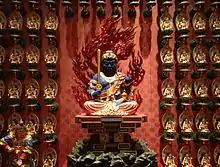
Lay persons or monks in yamabushi gear who go into rigorous training outdoors in the mountains often pray to small Acala statues or portable talismans that serve as his honzon.[1] This element of yamabushi training, known as Shugendō, predates the introduction of Acala to Japan. At this time, figures such as Zaō Gongen (蔵王権現), who appeared before the sect's founder, En no Gyōja, or Vairocana, were commonly worshiped.[1] Once Acala was added to list of deities typically enshrined by the yamabushi monks, his images were either portable, or installed in hokora (outdoor shrines).[1] These statues would often be placed near waterfalls (a common training ground), deep in the mountains and in caves.[57]
Acala also tops the list of Thirteen Buddhas.[77] Thus Shingon Buddhist mourners assign Fudō to the first seven days of service.[77] The first week is an important observance, but perhaps not as much as the observance of "seven times seven days" (i.e. 49 days) signifying the end of the "intermediate state" (bardo).
Literature on Shingon Buddhist ritual will explain that Sanskrit "seed syllables", mantras and mudras are attendant to each of the Buddhas for each observance period. But the scholarly consensus seems to be that invocation of the "Thirteen Buddhas" had evolved later, around the 14th century[78][79] and became widespread by the following century,[78] so it's doubtful that this practice was part of Kūkai's original teachings.
In popular culture
- Gary Snyder's 1969 poem Smokey the Bear Sutra portrays Smokey Bear (the mascot of the U.S. Forest Service) as an incarnation of Vairocana (the "Great Sun Buddha") in a similar vein as Acala. Indeed, Acala's Mantra of Compassionate Help is presented in the text as Smokey's "great mantra."[80]
Gallery
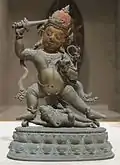 Gilt bronze statue from Tibet, 15th-16th century, Honolulu Museum of Art
Gilt bronze statue from Tibet, 15th-16th century, Honolulu Museum of Art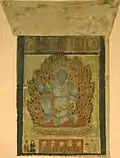
 Thangka depicting four-armed Acala, from Khara-Khoto, 13th-14th century
Thangka depicting four-armed Acala, from Khara-Khoto, 13th-14th century
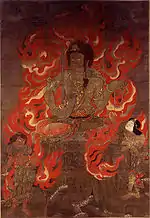
.jpg.webp) Acala with eight acolytes, Kamakura period, Nara National Museum
Acala with eight acolytes, Kamakura period, Nara National Museum.jpg.webp) The Kurikara sword flanked by Kiṃkara and Ceṭaka, Kamakura period, Nara National Museum
The Kurikara sword flanked by Kiṃkara and Ceṭaka, Kamakura period, Nara National Museum.jpg.webp) Drawing of four-armed Acala, from the Fudō Giki (1245)[81]
Drawing of four-armed Acala, from the Fudō Giki (1245)[81]-%E4%B8%89%E7%94%B0%E6%B4%9E%E5%BC%98%E6%B3%95-%E4%B8%A1%E9%A0%AD%E6%84%9B%E6%9F%93%E6%98%8E%E7%8E%8B%E5%9D%90%E5%83%8FMitahorakobo028.jpg.webp)
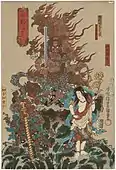
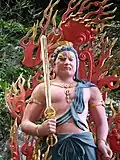

References
- Murakami 1988, Jp. rel. dict., pp.242–246
- Weston, David (2018). "The Bayer Collection — University of Glasgow" (PDF). The Bayer Collection.
- Donaldson, Thomas E. (2001). Iconography of the Buddhist Sculpture of Orissa: Text. Indira Gandhi National Centre for the Arts. pp. 219–221. ISBN 978-0-486-25575-0.
- Hugo Kreijger (1999). Kathmandu Valley painting: the Jucker collection. Shambhala. p. 123. ISBN 978-1-57062-454-4.
- Goble, Geoffrey C. (2019). Chinese Esoteric Buddhism: Amoghavajra, the Ruling Elite, and the Emergence of a Tradition. Columbia University Press. p. 65. ISBN 978-0-231-55064-2.
- Fudō Myōō and Myō-ō, Encyclopædia Britannica
- "不空羂索神變真言經". CBETA Chinese Electronic Tripiṭaka Collection. Chinese Buddhist Electronic Texts Association (CBETA). Retrieved 28 November 2020.
- Faure, Bernard (2015). The Fluid Pantheon: Gods of Medieval Japan, Volume 1. University of Hawai'i Press. p. 120. doi:10.21313/hawaii/9780824839338.001.0001. ISBN 978-0-8248-3933-8.
- "不空羂索神變真言經 第9卷". CBETA Chinese Electronic Tripiṭaka Collection. Chinese Buddhist Electronic Text Association (CBETA). Retrieved 28 November 2020.
- "大毘盧遮那成佛神變加持經 第1卷". CBETA Chinese Electronic Tripiṭaka Collection. Chinese Buddhist Electronic Text Association (CBETA). Retrieved 28 November 2020.
- Miyeko Murase (1975). Japanese Art. Metropolitan Museum of Art. pp. 31–32. ISBN 978-0-87099-136-3.
- [a] Charles Eliot (1998). Hinduism and Buddhism: An Historical Sketch. Routledge. pp. 391–392. ISBN 978-0-7007-0679-2.; [b] Charles Eliot (2014). Japanese Buddhism. Routledge. p. 136. ISBN 978-1-317-79274-1.
- Faure, Bernard (2015). The Fluid Pantheon: Gods of Medieval Japan, Volume 1. University of Hawai'i Press. pp. 120–123.
- Shincho 1985, under Fudo Myoo (in Japanese)
- Hodge, Stephen (2005). The Maha-Vairocana-Abhisambodhi Tantra: With Buddhaguhya's Commentary. Routledge. pp. 153–156. ISBN 978-1-135-79654-9.
- "The Tantra of Caṇḍamahāroṣaṇa". 84000: Translating The Words of The Buddha. Retrieved 28 November 2020.
- Weldon, David; Singer, Jane Casey (1999). The sculptural heritage of Tibet: Buddhist art in the Nyingjei Lam Collection. Laurence King Pub., p.100, "Aksobhya, the Buddha who presides over the family (kula) of deities with which Acala is associated"
- Jha, Achyutanand (1993). Tathagata Akshobhya and the Vajra Kula: Studies in the Iconography of the Akshobhya Family. National Centre for Oriental Studies. pp. 35–36.
- "Sacred Visions: Early Paintings from Central Tibet - Achala". www.asianart.com. Retrieved 28 November 2020.
- Pal, Pratapaditya (1974). The Arts of Nepal - Volume II: Painting. Brill Archive. p. 6. ISBN 978-90-04-05750-0.
- "Acala with Consort Vishvavajri". Metropolitan Museum of Art. Retrieved 28 November 2020.
- "Acala, The Buddhist Protector". Metropolitan Museum of Art. Retrieved 28 November 2020.
- Miyasaka, Yūshō (2006). 不動信仰事典 (Fudō-shinkō Jiten) (in Japanese). Ebisu Kōshō Shuppan. p. 56. ISBN 978-4-900901-68-1.
- 昭和新纂国訳大蔵経 解説部第1巻 (Shōwa shinsan Kokuyaku Daizōkyō: Kaisetsu, vol. 1) (in Japanese). Tōhō Shuppan. 1930. p. 120.
- "三輪身". コトバンク (kotobank) (in Japanese). Retrieved 28 November 2020.
- ja:護法善神, added 2008.4.23 (Wed) 06:02 by Boca samba (Japanese interwiki link to Dharmapala) makes this distinction.
- Shibata, Ichinō (1929). 日蓮宗教理史 (Nichiren-shū Kyōrishi) (in Japanese). Bukkyō Geijutsusha. p. 206.
- Kitao, Nichidai (1914). 新撰日蓮宗綱要 一名宗乗大意 (Shinsen Nichiren-shū kōyō: ichimyō shūjō taii) (in Japanese). Nisshū Shinpō Shisha. p. 296.
- The Nichiren Mandala Study Workshop (2013). The mandala in Nichiren Buddhism, Part One: Introduction, mandalas of the Bun'ei and Kenji periods. Lulu.com. p. 42. ISBN 978-1-304-28941-4.
- Ono, Seishū (1916). 聖不動経講義 (Sho-Fudō kyō kōgi). Oshima Seishindō. pp. 1–50.
- Kobayashi, Shōsei (1926). 真言宗聖典 (Shingon-shū seiten). Morie Shoten. pp. 131–141.
- Ono, Seishū (1916). 聖不動経講義 (Sho-Fudō kyō kōgi). Oshima Seishindō. pp. 51–60.
- Kobayashi, Shōsei (1926). 真言宗聖典 (Shingon-shū seiten). Morie Shoten. pp. 145–147.
- Ono, Seishū (1916). 聖不動経講義 (Sho-Fudō kyō kōgi). Oshima Seishindō. pp. 61–71.
- Kobayashi, Shōsei (1926). 真言宗聖典 (Shingon-shū seiten). Morie Shoten. pp. 142–144.
- Kodama, Giryū (2009). 印と梵字ご利益・功徳事典: 聖なる象徴に表された諸尊の姿と仏の教え (In to bonji goriyaku / kudoku jiten: sei naru shōchō ni hyōsareta shoson no sugata to Hotoke no oshie) (in Japanese). Gakken Publishing. p. 233. ISBN 978-4-05-404187-5.
- "Acala-Fudo Mantra". Visible Mantra. Retrieved 28 November 2020.
- cf. Getty, Alice (1988). The Gods of Northern Buddhism: Their History and Iconography. Courier Dover Publications. p.170, which mistakenly conflates the two Niō with Acala (Fudō) and Rāgarāja (Aizen).
- Sogeisha (1967). 梵字入門: 仏教美術考古学研究者のための [For the Buddhist art archaeologists: Introduction to Sanskrit]. 綜芸舎編集部. pp. 14–15. ISBN 9784794000040.
- Miyasaka, Yūshō (2006). 不動信仰事典 (Fudō-shinkō Jiten) (in Japanese). Ebisu Kōshō Shuppan. pp. 334–335. ISBN 978-4-900901-68-1.
- Giebel, Rolf W. (2005). The Vairocanābhisaṃbodhi Sutra (PDF). Numata Center for Buddhist Translation and Research. pp. 63, 223.
- 梵字入門 (Bonji nyūmon) (in Japanese). Sōgeisha. 1967. pp. 37–38. ISBN 978-4-7940-0004-0.
- "成田山のお不動さまとは – 大本山成田山新勝寺". 成田山新勝寺 (http://www.naritasan.or.jp). Retrieved 28 November 2020.
- "不動明王". 真言宗 慈照院. Retrieved 29 November 2020.
- "六角堂について". 太平山虚空蔵尊六角堂 (in Japanese). Retrieved 28 November 2020.
- "陀羅尼・慈救呪・陀羅尼助". 飛不動 龍光山正寶院 (tobifudo.jp). Retrieved 28 November 2020.
- Giebel, Rolf W. (2005). The Vairocanābhisaṃbodhi Sutra (PDF). Numata Center for Buddhist Translation and Research. p. 65.
- "初不動の日". 小豆島霊場 第二番 碁石山. 29 January 2018. Retrieved 29 November 2020.
- "不動明王のご真言". 倉敷成田山心和寺. Retrieved 29 November 2020.
- "火界呪". コトバンク (kotobank) (in Japanese). Retrieved 2 December 2020.
- Hatta, Yukio (1991). 現代語訳真言秘密行法 (Gendaigoyaku shingon himitsu gyōhō). Tōhō Shuppan. pp. 504, 684.
- Akiyama, Manabu. "呉音から西洋古典語ヘ (第1部) 印欧語文献としての弘法大師請来密教経典" (PDF). 文藝言語研究 言語篇 (Studies in Language and Literature: Language). University of Tsukuba. 61: 28.
- "The Tantra of Siddhaikavīra". 84000: Translating the Words of the Buddha. Retrieved 11 December 2020.
- "Achala (Buddhist Deity) - Blue, Standing". Himalayan Art. Retrieved 9 December 2020.
- "お不動様の台座". 成田山 東京別院 深川不動堂 (Fukagawa Fudō-dō Official Website). Retrieved 5 December 2020.
- "不動明王の髪型". 成田山 東京別院 深川不動堂 (Fukagawa Fudō-dō Official Website). Retrieved 5 December 2020.
- Snyder 1999 pg. 244
- "法愛 仏事の心構え". 法城山 護国寺 (Hōjō-zan Gokoku-ji Official Website). Retrieved 5 December 2020.
- Sato, Ken'ichi(佐藤貫一) (1961). 日本の刀剣 (snippet). Shibundo(至文堂). p. 81.
- Heibonsha (1969) [1968]. 世界百科事典(world encyclopedia)., article on "akafudo" by Tanaka, Ichimatsu (田中一松)
- Faure, Bernard (2015). The Fluid Pantheon: Gods of Medieval Japan, Volume 1. University of Hawaii Press. p. 144.
- "Fudō Myouō (Acalanatha)". e-Museum - National Treasures & Important Cultural Properties of National Institutes for Cultural Heritage, Japan. Retrieved 9 December 2020.
- Murase, Miyeko (1975). Japanese Art: Selections from the Mary and Jackson Burke Collection. Metropolitan Museum of Art. p. 31. ISBN 978-0-87099-136-3.
- "明王". 仏教ミニ辞典 (in Japanese). Retrieved 9 December 2020.
- "Buddhist Deity: Achala, White". Himalayan Art. Retrieved 9 December 2020.
- "不動明王立像(黄不動)". Mii-dera Official Website. Retrieved 9 December 2020.
- "金色不動明王画像". Mii-dera Official Website. Retrieved 9 December 2020.
- Miyasaka, Yūshō (2006). 不動信仰事典 (Fudō-shinkō Jiten) (in Japanese). Ebisu Kōshō Shuppan. p. 62. ISBN 978-4-900901-68-1.
- "黄不動". コトバンク (kotobank) (in Japanese). Retrieved 9 December 2020.
- Faure, Bernard (2015). The Fluid Pantheon: Gods of Medieval Japan, Volume 1. University of Hawaii Press. pp. 137–138.
- "Iconography Set: Achala (Zurich)". Himalayan Art. Retrieved 9 December 2020.
- Faure, Bernard (2015). The Fluid Pantheon: Gods of Medieval Japan, Volume 1. University of Hawaii Press. p. 125.
- Faure, Bernard (2015). The Fluid Pantheon: Gods of Medieval Japan, Volume 1. University of Hawaii Press. pp. 199–201.
- "両頭愛染明王". 仏様の世界. 飛不動 龍光山正寶院 (Tobi-Fudō Ryūkō-zan Shōbō-in). Retrieved 10 December 2020.
- Kagiwada, Seiko (2012). "両頭愛染曼荼羅の成立に関する一考察 (The Formation of the Mandala of Double-Headed Aizen)". Journal of Indian and Buddhist Studies (Indogaku Bukkyōgaku Kenkyū) (in Japanese). 60 (2): 615–618.
- Faure, Bernard (2015). The Fluid Pantheon: Gods of Medieval Japan, Volume 1. University of Hawaii Press. pp. 152–156.
- Yamada, Binyō (1894). The Nihon dai jisho. ISBN 978-0-8248-3261-2., Japanese Dictionary, p.748, middle row, under 「志ふさん・ぶつ.. (十三)佛」
- Gerhart, Karen M. (2009). The Material Culture of Death in Medieval Japan (preview). University of Hawaii Press. p. 22. ISBN 978-0-8248-3261-2.
- Kunishige, Masathoshi; illus. Kenji Kagwaguchi(川口健治) (1985). Utsukushiki kokyō Yamaguchi-ken Seibu-ban (美しき故郷山口県西部版) (preview). Fujimoto Printing Corporation. ISBN 978-4-901977-02-9., p.68 gives "late Kamakura Period"
- "Smokey the Bear Sutra". Inquiring Mind. Retrieved 12 December 2020.
- "恵林寺の文化財". 乾徳山 恵林寺 (Kentoku-san Erin-ji Official Website) (in Japanese). Retrieved 12 December 2020.
Sources
- Snyder, Gary (1999), "Smokey the Bear Sutra", The Gary Snyder Reader, Counterpoint, p. 241, ISBN 978-1-58243-079-9
- Kenkyusha's New Japanese-English Dictionary, Kenkyusha Limited, Tokyo 1991, ISBN 4-7674-2015-6
- Shincho (1985). 新潮世界美術事典 [Shincho Encyclopedia of World Art]. Shinchosha. ISBN 4-10-730206-7.
- Getty, Alice (1988). The Gods of Northern Buddhism: Their History and Iconography. Courier Dover Publications. p. 170. ISBN 978-0-486-25575-0.
- Murakami, Shigeyoshi(村上重良) (1988). 日本宗教事典 [Japanese religion dictionary]. Kodansha. ISBN 4-06-158837-0.
External links
| Wikimedia Commons has media related to Acala. |
- Fudo Myo-O, 不動明王 O-Fudo-sama in Japan
- Ellen Schattschneider "Fudo Myoo (Acala)" - In: immortal wishes (2003)
- Shingon Buddhist International Institute
- Tendai Buddhist Sangha in Denver Colorado

